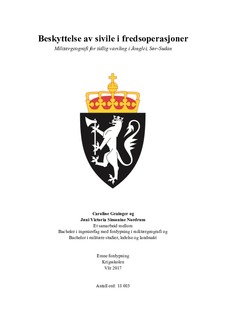| dc.description.abstract | Protecting civilians has become the forefront of modern UN peace operations and has emerged as a principal objective. However, civilian suffering does not seem to have been diminished. This study believes that a proactive approach is imperative for the effect of the peace operation. Early warning is therefore viewed as a key concept to implement proactive measures before the violence occur. This study attempts to contribute in bridging the gap between the strategical importance of protecting civilians and the tactical ability to actually shield them from violence by presenting the idea that military geography can be an early warning capacity. The study argues that it is through a profound understanding of the dynamic of the violence in an area of operations that relevant geographical information needs are identified. To explore this idea, the study is set in the geographical context of Jonglei in South-Sudan. The perpetrators’ motivation for committing violent attacks against civilians classifies Jonglei as a traditional communal conflict scenario. Here, communities engage in continuous cycles of brutal attacks driven by revenge and self-protection. Military forces are likely to play an important role in protecting civilians in this scenario. It is however essential to identify protection areas in order to prioritize the deployment of troops. For this early warning is needed. This study seeks to demonstrate the process that translates an understanding of the elements of the violence dynamics into information requirements to be processed by the military geographer. The answer to these requirements are then visualized in products that exemplifies the kind of decision making support a military geographer can yield. These include migration patterns, grazing areas, infrastructure, ethnic areas and history of violence. Their aggregation allows for identification of protection areas where the threat of violence against civilians appear more imminent. By monitoring, analyzing and making assessments on the physical and human terrain, military geographers can thus support military decision makers as a warning capacity. The main finding is that given the right direction, military geography as a discipline is highly relevant for early warning even in a nuanced low intensity operation against irregular threats. | nb_NO |
